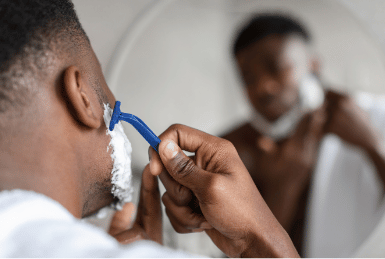
For a lot of people, knowing how to shave to avoid razor bumps will make a ton of difference on their skin and even self-confidence.
This article is about showing what to do before, during, and after shaving without having razor bumps.
Whether you are male or female, a teenager or an adult, razor bumps are a common problem for most people.
Once you hit puberty and hairs begin to grow out of your armpit, pubic area, and your face (facial hair such as beards), shaving these hairs puts you at risk of having razor bumps.
Razor bumps can cause your skin to itch, darken, or redden and even become inflamed.
A proper shaving technique will not only help you prevent these annoying bumps but will help your skin look smoother, and healthier and avoid other after-shave conditions such as razor burns, ingrown hair, itching, etc.

If you want to know the right way to prepare before you shave, what shaving tool is preferable, what to do after you shave to avoid razor bumps as well as how to maintain healthy skin generally then this article will help you greatly.
Razor bumps are usually pimple-like bumps on the shaved area of the skin that develop a few days after you shave.
They occur when hair strands curl back into the skin and begin to grow after shaving or when hair strands penetrate the skin without leaving the hair follicle leading to inflammation.
Razor bumps are most likely to occur with people who have curvy or coiled hair because this type of hair tends to easily bend which makes it easier to curl back into the skin. This is why it is most common among black people and some Hispanic people too.
Even though they both cause the skin to be red and irritated, what differentiates razor burn from razor bump is that while the former looks like a skin rash, the latter looks like a pimple. So do not mistake them for each other.
Bumps do not only occur when you use a razor/blades to shave, they also appear even when you remove hair by waxing, plucking, or using shaving creams.

The first step in avoiding razor bumps is having a pre-shave routine. Although many people might find having a pre-shave routine time-consuming, it is a very important step and should never be skipped.
Why?
It softens your hair which makes it easier to cut without unnecessarily pulling the hair and causing you pain. It can also help to reduce dryness in the area thereby avoiding irritation to the skin. Also, exfoliating before shaving can help in opening your pores and lift the hair for a smoother shave.
Before you shave, it is important to do the following:
Pro Tip: You can actually grow your hair: If you have the option, stop shaving and grow out your hair, which will eliminate the cause of your razor bumps
How to Practice Safe Sex Practices and Sexual Responsibility
Why it is Important to Drink Water after Sex
7 Health Benefits of Sleeping Naked
There are different shaving blades for different purposes. The type of blade you use to shave your head may not be the one you use to shave other areas of your body.
Also, depending on how low you want the hair, convenience of use, skin type, or even price, there are different options to explore when it comes to shaving tools.
They include but not limited to:
All three blades are very good, but making a preference depends on your needs. If you have sensitive skin, you may have to avoid using blades and rather explore other options such as waxing or sugaring.
You might also consider the use of shaving creams for sensitive skin. Products like Nivea Men Shaving Foam for sensitive skin, Veet Shaving Cream for sensitive skin, or even Edge Sensitive Skin Shave Gel are highly recommended and can be found in various shopping malls.
Pro Tip: Shave more often. shaving daily, or at least every 2-3 days, gives hair less time to grow and curve
The following is a step-by-step guide for a bump-free shave:
Even though most people tend to skip it, after-shave care is just as important as shaving, especially if you are prone to post-shave issues like razor bumps, irritation, dry skin, cuts, etc. Even if you do not experience these issues, you still need after-shave care to protect your skin.
Here’s a guide on what to do after you shave to avoid razor bumps:
Recommended post-shave products and remedies for reducing irritation:
TIP: Using a cool compress on the skin for a few minutes may help with irritation too.
The best skincare routine to prevent razor bumps and irritation is to shave every 2 to 3 days. This will prevent the hair from growing long enough to curl back into the skin.
However, it is important to always follow up with a moisturizing lotion immediately to avoid irritation and dryness.
In cases where the bumps are already on the skin, it is advised not to continue shaving over the bumps but to give them a break until completely healed.
Medical aestheticians and skincare experts like Amy Peterson agree that “exfoliation is the key to preventing ingrown hairs or razor bumps. That’s really the only way you can prevent them.”
She goes further to add that “it is important to prepare the skin and hair before shaving by loosening the hairs with a gentle exfoliating cleanser such as one that contains alpha or beta hydroxy acids.”
Therefore, moisturize and hydrate your skin for optimal healing and rejuvenation after shaving to avoid razor bumps.

Whether you are shaving your face, armpit, legs, or pubic area, it’s the same technique if you want to avoid razor bumps.
The most important things to keep in mind are to: prep your skin before shaving, shave in the direction of hair growth, and follow up with after-shave care, and you’re good to go.
Now that you know how to avoid razor bumps, you may ask, how can I treat existing razor bumps? Well, there are a few home remedies for getting rid of razor bumps such as:
1. Applying a cold compress to soothe swelling on the affected area.
2. Applying aloe vera gel which is known for its soothing and healing properties.
3. Applying tea tree oil which is anti-inflammatory and antimicrobial.
4. Scrubbing with a natural scrub instead of a chemical-based scrub.
5. Using garlic on the area since it also has anti-inflammatory and antifungal/antibacterial qualities.
Razor bumps usually heal on their own after some weeks or even months, but in cases where your symptoms don’t resolve within a few weeks, talk to a doctor or a certified dermatologist to ensure there are no other causes for your symptoms.
Razor bumps do not pose any serious or life-threatening health issues; however, they are not a pleasant sight to behold and can affect a person’s confidence. Something as simple as changing or improving your shaving habit and routine can free you of your struggles.
This article outlines several ways to shave to avoid razor bumps and treat them if they occur. With the help of this article, you now have a good knowledge of safe shaving practices and the confidence to wear that bikini or singlet with a smile.
So, KompleteCare encourages you to practice proper pre-shaving, shaving, and post-shaving techniques each time you shave to avoid razor bumps.
If you are having some strange symptoms or need professional medical advice on how to shave to avoid razor bumps, consult a doctor on KompleteCare today!
The best way to shave to avoid razor bumps is to wash your skin with a non-comedogenic cleanser before shaving. Additionally, always use a moisturizing shaving cream while you shave. Thereafter, apply an aftershave on the shaved area to prevent razor bumps.
Razor bumps typically resolve on their own, within 2 or 3 weeks after shaving. If you re-shave the area, it triggers the razor bumps again.
Razor bumps occur when the razor cuts curly, coarse, or short hair strands. These hair strands curl back into the skin and begin to grow after shaving or when hair strands penetrate the skin without leaving the hair follicle leading to inflammation and ingrown hair. Your skin will react to these ingrown hairs, thus creating razor bumps.
Using an alcohol-free after-shave, rinsing with warm water, and patting the shaved area dry with a clean towel will usually do the trick. However, to speed things up, you can apply exfoliants (like a scrub) on the area. This will clear the pores of dead skin cells and encourage the trapped hair to come out. If your razor bumps get inflamed or irritated, use aloe vera and ice.
Some people shave regularly (even daily) to keep the pubic area smooth and hairless. However, shaving regularly has drawbacks. The razor on the shaving stick can harbor bacteria and cause some abrasion of the skin. When this occurs, especially in a moist environment, it creates a breeding ground for a bacterial skin infection.
When experiencing razor bumps, people will usually surf the internet for quick solutions on how to shave to avoid razor bumps and even diagnosis. While this is very proactive, you may come across misleading information. Additionally, what works for Mr. A won’t work for Mr. B.
With telemedicine, you can share your symptoms, medical history, allergies, and other relevant information with dermatologists or skin care specialists. These professionals will identify the underlying causes of your razor bumps or skin irritation. They will also streamline treatment options and product recommendations, and teach you how to shave to avoid razor bumps.
Additionally, telemedicine makes it very convenient for patients to follow up after a dermatology appointment on their shaving practices and response to the recommended treatments.
American Academy of Dermatology (2022) How to prevent razor bumps
American Academy of Dermatology (2022) 6 razor bump prevention tips from dermatologists
Healthline (2023) Razor Bumps: Causes, Home Remedies, and Treatment
Medical News Today (2023) Razor bumps: How to treat and prevent them
NutritionFebruary 5, 2025
MedicationFebruary 5, 2025








